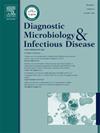新一代宏基因组测序在痰液稀少或痰液病原学检查结果阴性的疑似肺结核患者中的诊断价值。
IF 2.1
4区 医学
Q3 INFECTIOUS DISEASES
Diagnostic microbiology and infectious disease
Pub Date : 2024-12-03
DOI:10.1016/j.diagmicrobio.2024.116633
引用次数: 0
摘要
目的:比较mNGS与常规检查对痰少或痰学检查阴性的疑似肺结核(PTB)患者的诊断价值。方法:纳入2018 - 2021年我科收治的符合条件的患者。他们的支气管肺泡灌洗液(BALF)和肺活检组织样本送去mNGS和常规检查。比较了mNGS与常规检查的诊断价值。结果:226例入组患者中有94例诊断为肺结核。mNGS的诊断符合率在所有样本中均显著高于抗酸染色(p < 0.001),在BALF样本中也显著高于培养(p = 0.011)。mNGS联合常规试验的AUC显著高于mNGS单独试验(p = 0.013)。结论:mNGS具有较高的诊断价值。mNGS与常规检测相结合,更可靠地准确诊断这些疑似肺结核患者。本文章由计算机程序翻译,如有差异,请以英文原文为准。
The diagnostic value of metagenomic next-generation sequencing in suspected pulmonary tuberculosis patients with scarce sputum or negative sputum etiological test results
Objective
To compare the diagnostic value between mNGS and conventional tests in suspected pulmonary tuberculosis (PTB) patients with scarce sputum or with negative sputum etiological test results.
Methods
We enrolled eligible patients admitted to our department from 2018 to 2021. Their bronchoalveolar lavage fluid (BALF) and lung biopsy tissue samples were sent for mNGS and conventional tests. The diagnostic value of mNGS was compared respectively with that of conventional tests.
Results
94 of 226 enrolled patients were diagnosed PTB. The diagnostic concordance rate of mNGS was significantly higher than that of acid-fast staining in all samples (p < 0.001), as well as that of culture in BALF samples (p = 0.011). mNGS in parallel with conventional tests had significantly higher AUC than mNGS alone (p = 0.013).
Conclusions
mNGS has higher diagnostic value than some conventional tests. mNGS in parallel with conventional tests is more reliable to accurately diagnose these suspected PTB patients.
求助全文
通过发布文献求助,成功后即可免费获取论文全文。
去求助
来源期刊
CiteScore
5.30
自引率
3.40%
发文量
149
审稿时长
56 days
期刊介绍:
Diagnostic Microbiology and Infectious Disease keeps you informed of the latest developments in clinical microbiology and the diagnosis and treatment of infectious diseases. Packed with rigorously peer-reviewed articles and studies in bacteriology, immunology, immunoserology, infectious diseases, mycology, parasitology, and virology, the journal examines new procedures, unusual cases, controversial issues, and important new literature. Diagnostic Microbiology and Infectious Disease distinguished independent editorial board, consisting of experts from many medical specialties, ensures you extensive and authoritative coverage.

 求助内容:
求助内容: 应助结果提醒方式:
应助结果提醒方式:


